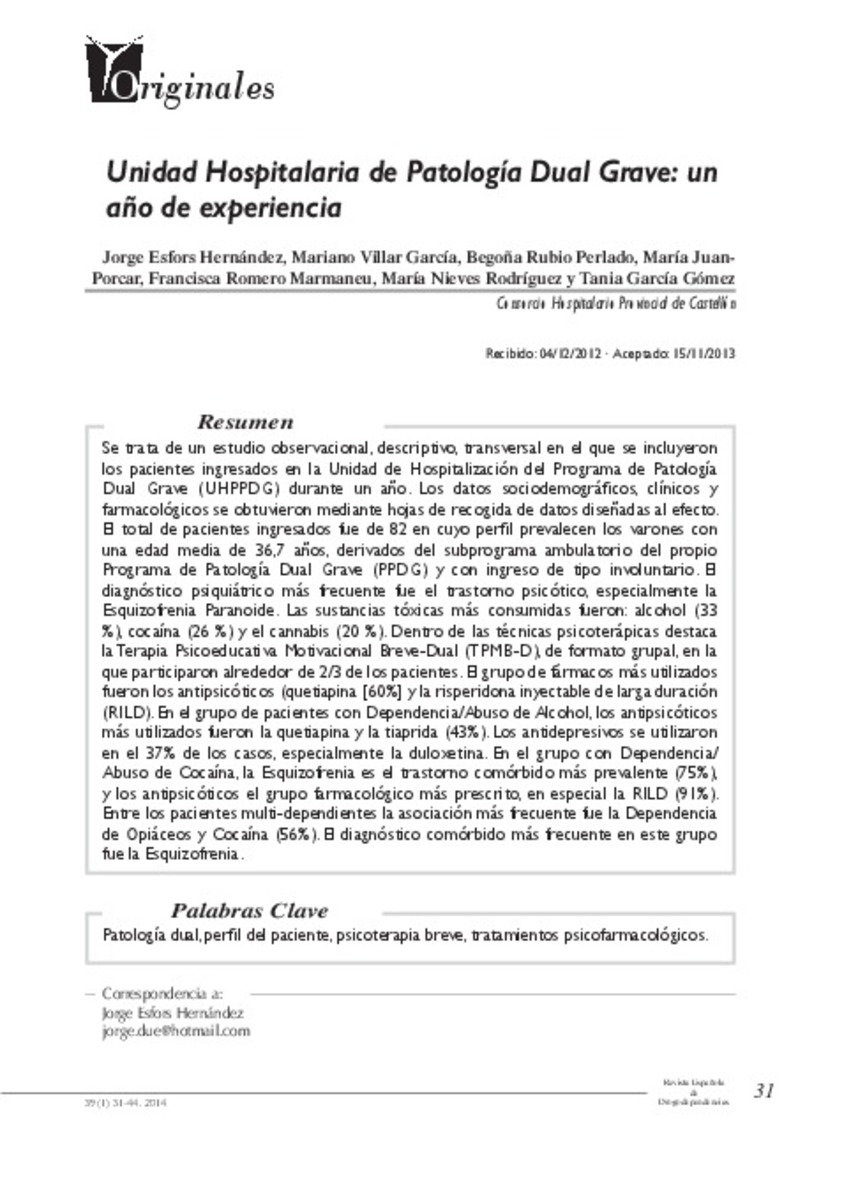Mostrar el registro sencillo del ítem
Unidad Hospitalaria de Patología Dual Grave: un año de experiencia
| dc.contributor.author | Juan Porcar, María | |
| dc.contributor.author | Esfors Hernández, Jorge | |
| dc.contributor.author | Villar García, Mariano | |
| dc.contributor.author | Rubio Perlado, Begoña | |
| dc.contributor.author | Romero Marmaneu, Francisca | |
| dc.contributor.author | Rodríguez, María Nieves | |
| dc.contributor.author | García Gómez, Tania | |
| dc.date.accessioned | 2015-09-09T08:52:35Z | |
| dc.date.available | 2015-09-09T08:52:35Z | |
| dc.date.issued | 2014 | |
| dc.identifier.citation | Esfors Hernández, Jorge, et al. Unidad Hospitalaria de Patología Dual: un año de experiencia. REVISTA ESPAÑOLA DE DROGODEPENDENCIAS. (2014) Num. 1 (39). pp. 31-44. | ca_CA |
| dc.identifier.issn | 0213-7615 | |
| dc.identifier.uri | http://hdl.handle.net/10234/131686 | |
| dc.description.abstract | This is an observational, descriptive, cross-sectional study on patients admitted for one year to the inpatient unit of a Severe Dual Diagnosis Program (SDDP). Socio- demographic, clinical and pharmacological information was obtained using data collection forms designed for this purpose. The sample size was of 82 inpatients, whose profile was that of males with a mean age of 36.7 years, referred from the outpatient clinic of the SDDP. Admission was mainly involuntary. The main psychiatric diagnosis was psychotic disorder, especially paranoid schizophrenia, and the most prevalent substances consumed were alcohol (33%), cocaine (26%) and cannabis (20%). Among the psychotherapeutic techniques worthy of mention, there was a Brief Motivational Psycho-educational Therapy-Dual (BMPT-D) with a group format, in which around two thirds of the patients participated. The most widely-used group of drugs was antipsychotics, specifically quetiapine [60%] and the long-term action injectable risperidone (LAIR, 51%). In the group of patients with alcohol abuse or dependence, the most commonly prescribed antipsychotics were quetiapine and tiapride (both 43%). Antidepressants were used in 37% of cases, especially duloxetine. In the group with cocaine abuse or dependence, schizophrenia was the most prevalent co-morbid disorder (75%) and the most widely-prescribed drugs were antipsychotics, especially LAIR (91%). Opioid and cocaine dependence was the most common association within the multi-dependent patients (56%) and schizophrenia the most frequent co-morbid diagnosis in this group. | ca_CA |
| dc.description.abstract | Se trata de un estudio observacional, descriptivo, transversal en el que se incluyeron los pacientes ingresados en la Unidad de Hospitalización del Programa de Patología Dual Grave (UHPPDG) durante un año. Los datos sociodemográficos, clínicos y farmacológicos se obtuvieron mediante hojas de recogida de datos diseñadas al efecto. El total de pacientes ingresados fue de 82 en cuyo perfil prevalecen los varones con una edad media de 36,7 años, derivados del subprograma ambulatorio del propio Programa de Patología Dual Grave (PPDG) y con ingreso de tipo involuntario. El diagnóstico psiquiátrico más frecuente fue el trastorno psicótico, especialmente la Esquizofrenia Paranoide. Las sustancias tóxicas más consumidas fueron: alcohol (33 %), cocaína (26 %) y el cannabis (20 %). Dentro de las técnicas psicoterápicas destaca la Terapia Psicoeducativa Motivacional Breve-Dual (TPMB-D), de formato grupal, en la que participaron alrededor de 2/3 de los pacientes. El grupo de fármacos más utilizados fueron los antipsicóticos (quetiapina [60%] y la risperidona inyectable de larga duración (RILD). En el grupo de pacientes con Dependencia/Abuso de Alcohol, los antipsicóticos más utilizados fueron la quetiapina y la tiaprida (43%). Los antidepresivos se utilizaron en el 37% de los casos, especialmente la duloxetina. En el grupo con Dependencia/ Abuso de Cocaína, la Esquizofrenia es el trastorno comórbido más prevalente (75%), y los antipsicóticos el grupo farmacológico más prescrito, en especial la RILD (91%). Entre los pacientes multidependientes la asociación más frecuente fue la Dependencia de Opiáceos y Cocaína (56%). El diagnóstico comórbido más frecuente en este grupo fue la Esquizofrenia. | ca_CA |
| dc.format.extent | 14 p. | ca_CA |
| dc.format.mimetype | application/pdf | ca_CA |
| dc.language.iso | spa | ca_CA |
| dc.publisher | Asociación Española de Estudios en Drogodependencias | ca_CA |
| dc.rights.uri | http://rightsstatements.org/vocab/CNE/1.0/ | * |
| dc.subject | patología dual | ca_CA |
| dc.subject | perfil del paciente | ca_CA |
| dc.subject | psicoterapia breve | ca_CA |
| dc.subject | tratamientos psicofarmacológicos | ca_CA |
| dc.subject | dual diagnosis | ca_CA |
| dc.subject | patient profile | ca_CA |
| dc.subject | brief psychotherapy | ca_CA |
| dc.subject | psychopharmacological treatments | ca_CA |
| dc.title | Unidad Hospitalaria de Patología Dual Grave: un año de experiencia | ca_CA |
| dc.type | info:eu-repo/semantics/article | ca_CA |
| dc.rights.accessRights | info:eu-repo/semantics/openAccess | ca_CA |
| dc.relation.publisherVersion | http://www.aesed.com/descargas/revistas/v39n1_2r.pdf | ca_CA |
| dc.type.version | info:eu-repo/semantics/publishedVersion |
Ficheros en el ítem
Este ítem aparece en la(s) siguiente(s) colección(ones)
-
INF_Articles [273]
Articles de publicacions periòdiques







